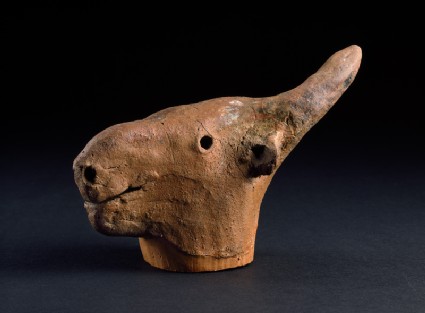Room 12 | India 2500 BC-AD 600 gallery
Explore the early development of Indian art, from the artefacts of the Indus Valley to the Hindu and Buddhist sculpture of north India and Gandhara.

Galleries : 116 objects
Terracotta head of an animal, possibly a bull
-
Details
- Associated place
-
Asia › India › south India › Andhra Pradesh › Motamari (place of excavation)Asia › India › south India › Andhra Pradesh › Motamari (place of creation)
- Date
- 7th century BC - 2nd century AD
- Associated people
-
E. H. Hunt (active early 20th century) (excavator)
- Material and technique
- terracotta
- Dimensions
-
10 x 14 x 6.8 cm max., after restoration (height x width x depth)
9.5 x 14 x 6.8 cm max. (height x width x depth)
- Material index
- Object type index
- No. of items
- 1
- Accession no.
- EAX.236
-
Further reading
Harle, J. C., and Andrew Topsfield, Indian Art in the Ashmolean Museum (Oxford: Ashmolean Museum, 1987), no. 4 on pp. 4-5, illus. p. 5
Ahuja, Naman, ‘Early Indian Art at the Ashmolean Museum - Catalogue in progress’, 2016, no. 25.2
Location
Objects are sometimes moved to a different location. Our object location data is usually updated on a monthly basis. Contact the Jameel Study Centre if you are planning to visit the museum to see a particular object on display, or would like to arrange an appointment to see an object in our reserve collections.
Publications online
-

Indian Art in the Ashmolean Museum
The Museum has a collection of megalithic wares from several sites near Hyderbad in Andhra, excavated in the 2nd and 3rd decades of this century by E.H. Hunt and belonging to what is termed the South Indian Iron Age or Megalithic Grave Complex. While iron age graves in Andhra and Tamilnadu characterised by the megalithic wares have been extensively investigated, they have been marked by an almost total absence of the terracottas depicting humans and animals which are such a common feature of the early historical period in India. This may be due, of course, to the fact that very few settlements, as opposed to graves, have belonged to complete animals, appear to be unique.
The heads portrayed [EAX.235 and EAX.236] are of quite different animals. One would appear to be an antelope with its relatively pointed head and straight swept-back horns. The other has a highly distinctive appearance and since there appear to be no other examples in pre-historic or early Indian art, one must assume that the animal was known to the modeller. With its straight-sided jaw and raised nasal region, indicating what appears to be an abnormally large nasal cavity, there is a striking resemblance between the animal depicted and a saiga (Saiga tatarica) of S.E. Russia and parts if Central Asia.
Galleries
Notice
Objects may have since been removed or replaced from a gallery. Click into an individual object record to confirm whether or not an object is currently on display. Our object location data is usually updated on a monthly basis, so contact the Jameel Study Centre if you are planning to visit the museum to see a particular Eastern Art object.
© 2013 University of Oxford - Ashmolean Museum










